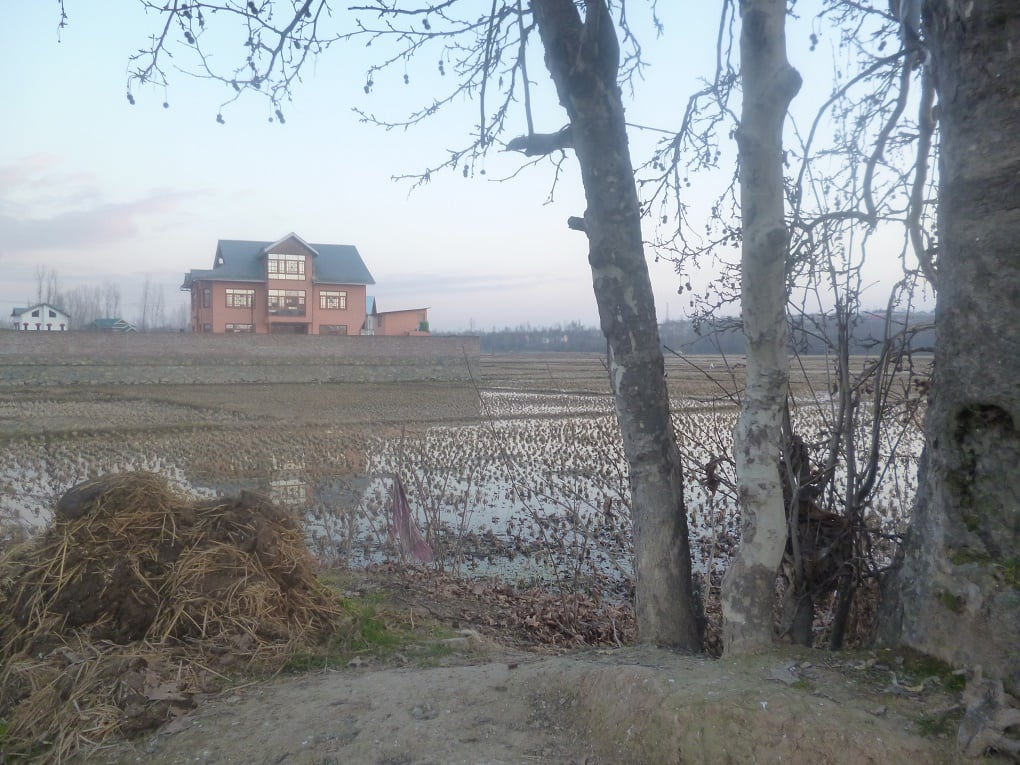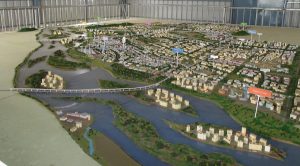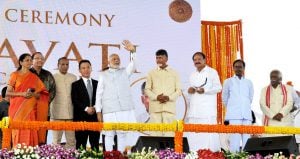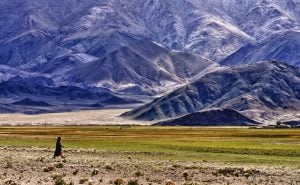Ten years ago, Ganderbal was a small town in the north of Srinagar. But in 2006 it became the district headquarters, and the town has grown out of all proportion. The large paddy fields separating the town from the nearby villages of Tulumula, Wahidpora and Beehama are now the sites of multi-storied commercial complexes, shopping malls, schools, service centres and residential colonies.
Ganderbal is not alone. Three more district headquarters were created that year, and the frenzy of construction turned a significant amount of agricultural land into the built-up space. Kashmir has witnessed a steady conversion of farmland into non-agricultural use over the past three decades. In the last six years alone, about 20% of agricultural land has been converted for commercial or residential purposes.
This has had a direct effect on agricultural productivity in the state of Jammu & Kashmir (J&K). According to Jammu and Kashmir Economic Survey report 2014-15, the estimated contribution of agriculture to State Gross Domestic Product (GSDP) has fallen from 28% in 2004-5 to 17%. The shortfall in food grains, which was 32% in 1950-51, is now 82 %.
The survey goes on to note that, while 70% of the population depends directly or indirectly on agriculture, the proportion of the labour force engaged in agriculture has declined from 85% in 1961, to 28% today. Farmers have not found other work in J&K, due to the absence of a viable industrial and service sector.
The lack of industry or service sector and rapid urbanisation in Kashmir are linked due to the conflict of the last two and a half decades. Due to militancy and counter-insurgency operations, the rural areas where the most unsafe, so many rural residents fled to bigger cities, principally Srinagar, for safety. At the same time, investors also fled from the Kashmir valley. According to 2014-15 J&K economic survey, the largest urban area is in Srinagar district, where 98.6% of people live in urban areas, followed by Jammu district with 50%. In 2011, a London based-based City Mayors Foundation came out with a ranking of the fastest growing urban areas in the world, and Srinagar ranked 92 out of the top 300 such urban areas.
Building on flood plains
The frenetic growth of the city is exemplified by a chaotic construction of hundreds of residential houses over a wide marshy stretch of the land between Bemina and Batmaloo. Residential colonies have come up in the low-lying flood plains of Kandizaal, Soitang, Padshahi Bagh, Kursoo, Ibrahim Colony and further downstream on the Jhelum River. These areas used to be the flood basin of Jhelum and their filling up contributed to unprecedented flooding in September 2014.
In 2012, the J&K High Court passed directions against the misuse of agricultural land following a Public Interest Litigation by a non-government organisation. The court directed all deputy commissioners to ensure the Jammu and Kashmir Agrarian Act and the Jammu and Kashmir Land Revenue Act are enforced to stop the conversion of agricultural land.
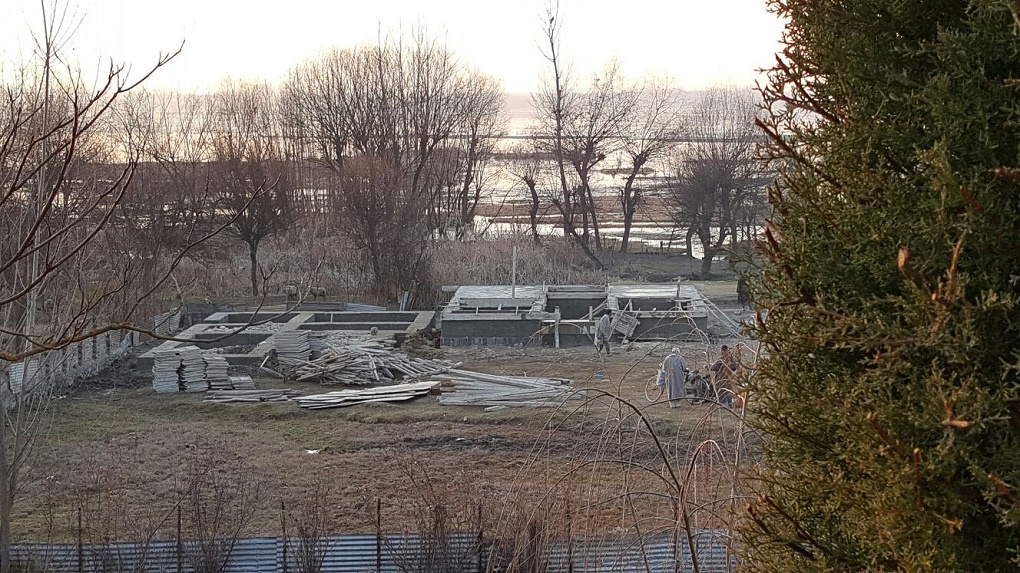
Unfortunately these laws have often been violated by the government itself. Across Bemina the state government has constructed colleges, offices and even the Srinagar Development Authority on marshy land that once acted as the city’s flood basin.
As the cities have expanded, land prices have skyrocketed. In 2005, Shabir Ahmad Bhat sold off ten kanals (1.25 acres) of his paddy fields in Ganderbal to buy a house in Srinagar. Ten years later he is happy with decision. “My house now costs three times as much as what my land would cost now in Ganderbal,” says Shabir. “Besides, the annual yield of paddy wasn’t worth the investment and the effort”.
Shabir is right. Because of the lack of high yielding seed varieties, the average rice yield in J&K is about 2,085 kgs per hectare versus 3,952 kgs in the state of Punjab or 6,661 kgs in China. “We don’t easily take to seed replacement. I think only 15% of our rice come from high yielding varieties” says Mohammed Yousuf Zargar, dean of the Faculty of Agriculture at the Sher-e-Kashmir University of Agricultural Sciences and Technology of Kashmir (SKUAST). “SKUAST produces good seeds, but the state government should persuade people to adopt them”.
Indus Waters Treaty and irrigation
Beyond the lack of high-yield seeds, J&K also faces a unique challenge to agriculture because the Indus Waters Treaty (IWT) between India and Pakistan restricts the building of irrigation facilities.
Only 42% of the state has access to irrigation. “Due to Indus Water Treaty, J&K is bound to use its hydro-resources at a sub-optimal level,” says Nisar Ali, a former member of the J&K Finance Commission. “Secondly, the three river basins Jehlum, Chinab and Sindh which are subject to IWT provisions survive on snowfall in winter months which inevitably reduces the water level and velocity of water flow during the lean period, which is at least seven months in a year.”
Under the treaty the state cannot build reservoirs or dams on these rivers without prior approval of Pakistan. Nor can it construct any barrage for irrigation. India’s storage entitlement on Sindh, Jhelum and Chenab is just 0.25 million acre feet (MAF), 0.50 MAF and 0.50 MAF respectively.
In the past Pakistan has objected to Indian attempts to build water storage projects such as the Wullar Barrage in north Kashmir which, if built, could help irrigate the vast catchment area of the lake. Pakistan argues that the barrage or any other such storage dams could drastically reduce water flows to the country during the crucial sowing season.
Effect of receding glaciers
There are also fears for the future, especially with receding glaciers and their impact on river flows. Shakil Ahmad Romshoo, Professor of Earth Sciences, at the University of Kashmir, has expressed fears that this will limit the amount of water available for irrigation. Of particular concern is the Kolahai glacier. In 2009, Professor Romshoo presented the findings of a three year project on the glacier, which is the biggest in the Kashmir Valley, and the source of the Lidder and Sindh, two major rivers that join the Jhelum. He found that the glacier was retreating by 0.08 sq km a year.
“If the recession of the Himalayan glaciers goes on at this rate, the discharge in state’s rivers would substantially go down,” said Ramshoo.
As agriculture falters within the state, and J&K becomes more and more dependent on importing grains, other divides are surfacing. One glimpse of its dangerous fallout was provided by the recent protests over the state government’s move to implement the National Food Security Guarantee Act, whereby every ration card holder will only get five kg of rice per month, against the existing limit of 35 kg per family. People took to streets in Srinagar and across other urban centres. The act was even opposed by the separatist groups who normally don’t respond to day to day governance issues.
“This Act is inhuman and anti-people,” said the moderate Hurriyat chairman Mirwaiz Umar Farooq. “This will force people into starvation”.
